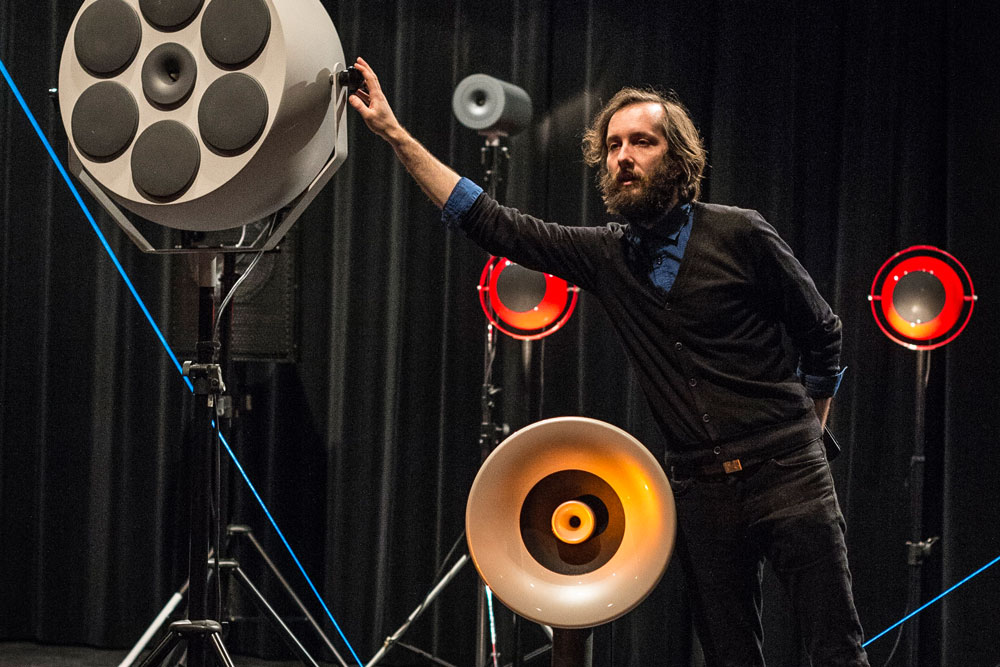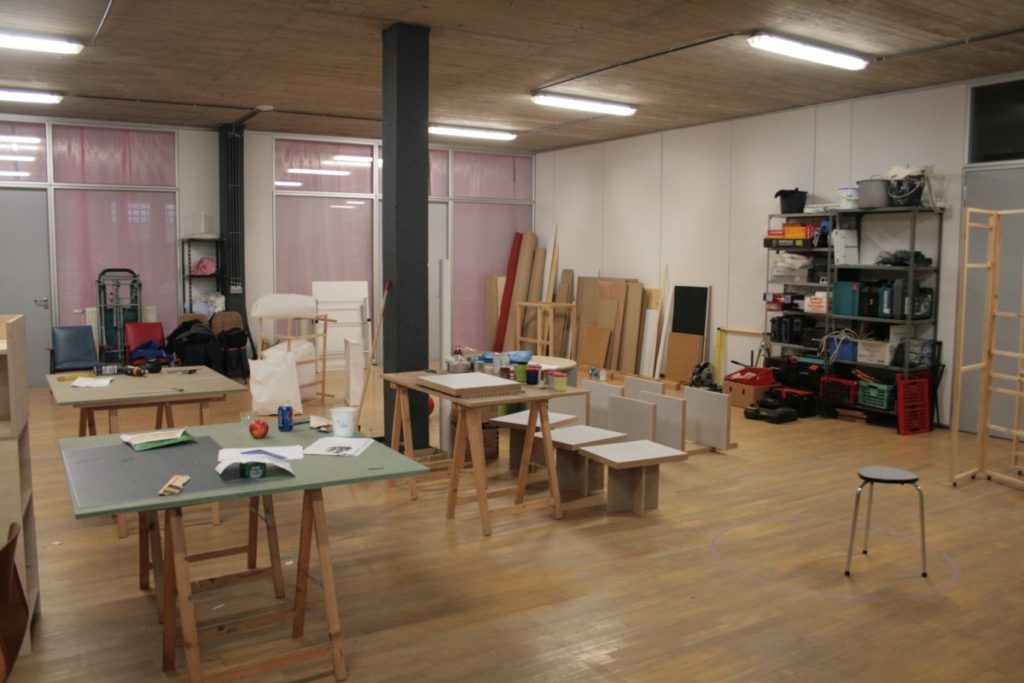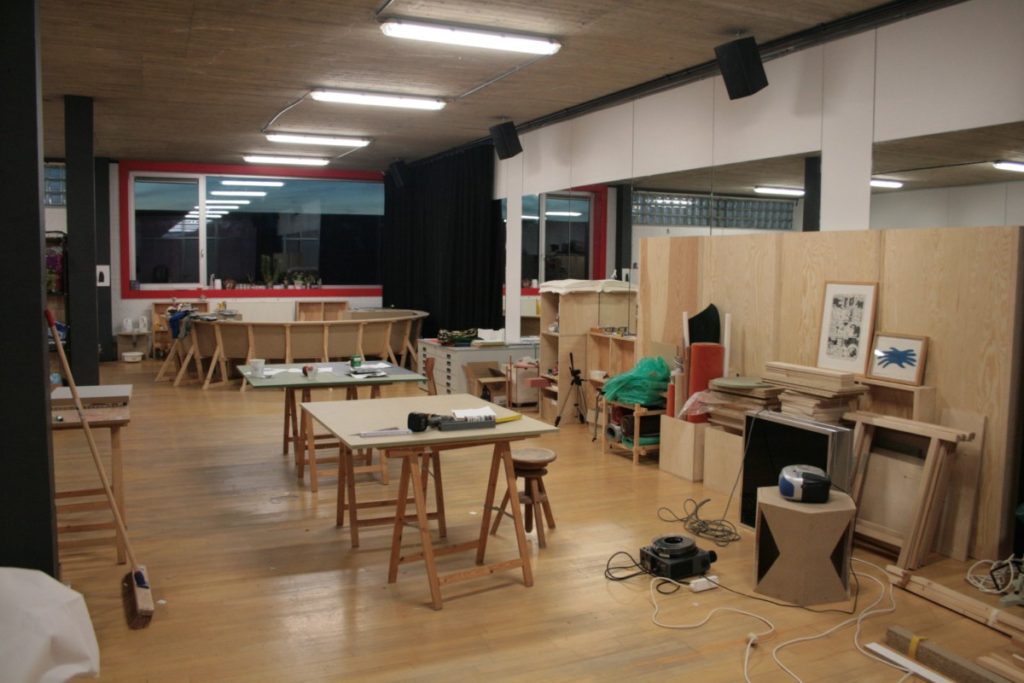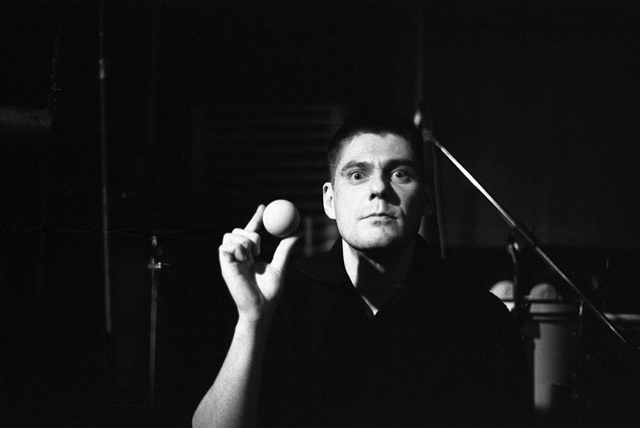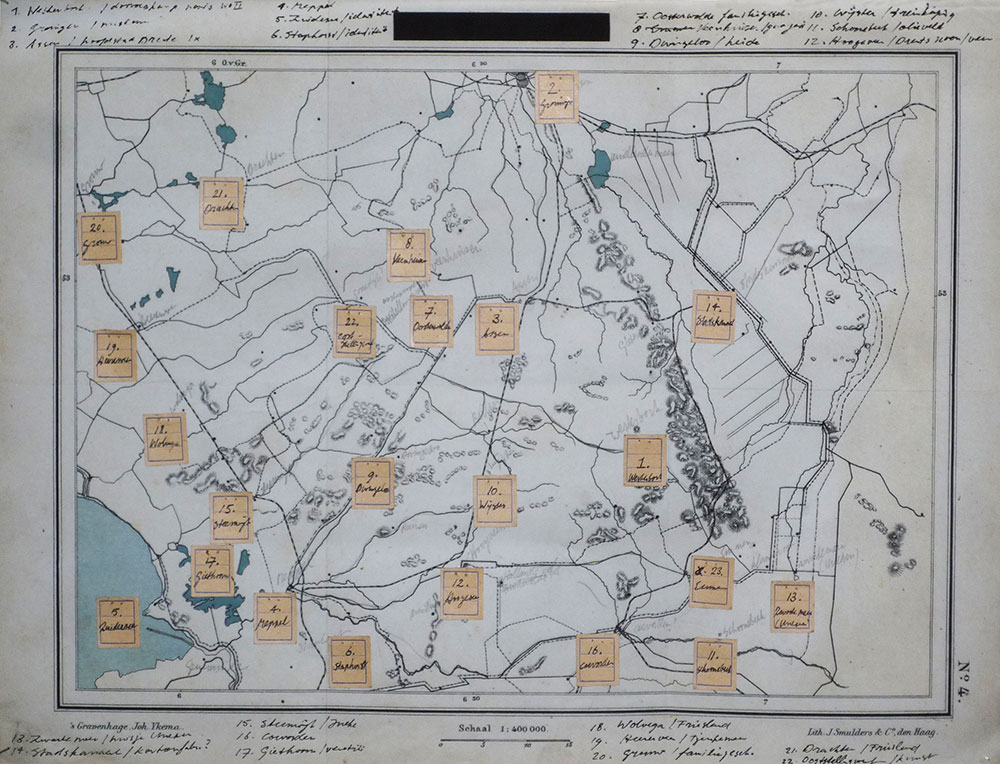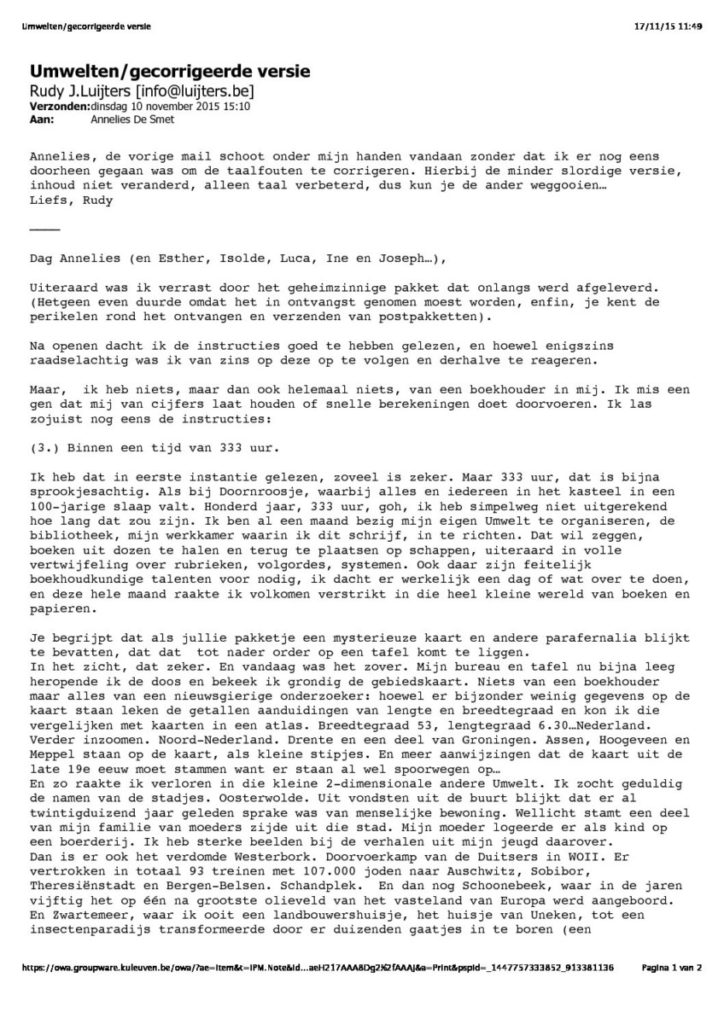When different people gather around the same idea or form, the outcome is more than the sum of their minds. A so-called third mind comes into play. According to William S. Burroughs and Brion Gysin, this third mind does things that none of the single brains would have come up with. How important are collaboration and (audience) participation to you? How do other people and other worlds become part of your work? How do you create a third mind?
Question FourAccording to Gilles Deleuze, the encounter between two disciplines doesn’t take place when one begins to reflect on one another, but when one discipline realizes that it has to resolve, for itself and by its own means, a problem similar to one confronted by the other. What art forms and disciplines other than your own do you feel close to? Do you incorporate strategies or practices from other disciplines, sciences or domains of society?
Question FiveDo you have certain rituals or methods to help crystalize and materialize your ideas and intuitions into artworks, texts or designs? In preparation for your work, do you take photographs, do you make drawings or schemas, take notes, build models and so on?
Question SixIn 1911, Henri Matisse painted his studio as a visual manifesto of his art practice. The clock in the background and the circular composition testify to the continuous making and remaking of his art. Do you learn through making? Imagine falling into an amnesiac state. Would this state be a blessing or a curse for your future work?
Question SevenHow do you know that a work is finished? Are you in need for (self-imposed) deadlines? Do you experience your time at work as a continuous process or are there frequent ups and downs, moments of despair and enlightenment? Do you recall certain moments or specific works that became models of thought afterwards?
François J. Bonnet is a Franco-Swiss composer, electroacoustic musician. He is the artistic director of the prestigious institute Ina GRM and the curator of the Recollection GRM series on Editions Mego label. He is also a writer and theoretician (The Order of Sounds, a sonorous Archipelago and The Infra-World have been published in english by Urbanomic). As a musician, Bonnet has been collaborating under the name Kassel Jaeger with artists such as Oren Ambarchi, Giuseppe Ielasi, Stephan Mathieu, Jim O’Rourke, Akira Rabelais and James Rushford. Kassel Jaeger’s works are a complex balance between concrète experimentalism, ambient noise, and electroacoustic improv. He has released several albums on various labels such as Editions Mego, Shelter Press, Senufo Editions, Unfathomless.
My work, as theoretician and musician, is fragmented in a lot of different spaces. From sound captures to mastering, from reading a book, or talking to someone that will trigger the first idea to publishing, there’s no proper locus where my work is generated.
Each step requires its own space and often these steps are woven together, so are the spaces.
I have a workspace, very compact and functional, inhabited with small objects, small fetishes (a dried edelweiss flower, a small bone carved skull). Strangely, I almost never sit and work there.
I’d like to have books, music, things, nearby, but hidden. Most of my books are stored in closets. I can access them whenever I want, but I am not under their look all the time. Same with pieces of art, some of them are always visible, some are always hidden. I move some others regularly from a hidden spot to a visible one.
Collaboration is important. At one point, you feel the need to break your own procedures and create new ones. You can do it alone, but working with people, exchanging ideas, observing others at work is invaluable.
I’m not sure I would call it “third mind”, but whatever is created through collaboration is rarely the fruit of strategy. If it was, it would be precisely the sum of two brains. Therefore, you don’t create it. It creates itself through you. And, as it’s not a being, as it’s nothing, it is just, at the end, the resultant of two or more minds that didn’t foresee what they could actually do together and do it anyway. That’s the beauty of it, so maybe it deserves to be called the third mind, even if it doesn’t exist.
I’ve been studying visual arts, without producing much. I’m still working in this field from time to time, but rarely. However I think the entanglement of concept and materialization, the way they resonate together to inform each other and the way visual art can include exogenous elements has been very influential. It’s the best way to prevent one’s tendency to fall into formalism. Formalism rises when exogeneity disappears.
Sometimes, in order to prepare some pieces of music, I write some lines, draw some sketches. They’re nothing but rituals, because they usually have very little to do with the actual compositional process which, in my work, bypass, as much as possible, the representational regime to favor the listening and sonic experience as sole compass.
Of course you learn through making, and at the same time, the more you learn, the more the other paths you could have taken become remote, unless your learning practice is not based on authoritarian routine and is not used to enforce and confirm your worldview. Easier said than done.
I know a work is finished when there’s nothing more I can do.
In het recentere werk van Hans Demeulenaere staat de subjectiviteit van de ruimtelijke beleving, perceptie en oriëntatie centraal. Steeds in het besef dat de realiteit zich nooit afdoend laat grijpen. Architectuur vormt hiertoe het belangrijkste uitgangspunt. Deze wordt herleid tot schaalmodellen of plattegronden die op hun beurt het uitgangspunt vormen van de uiteindelijke ruimtelijke installatie.
Daarnaast gaat Hans Demeulenaere ook op zoek naar de werking van architecturale structuren en meubelstukken. Hij ontrekt ze uit hun context en bouwt ze opnieuw op met respect voor verhoudingen en herkenbaarheid. Enkel worden ze onbruikbaar. Steeds is er een verwijzing aanwezig die de beleving en perceptie ervan in vraag stelt.
Beschrijving van mijn werkruimte; mijn werkruimte is een gehuurd (en tijdelijk) pand, met het gevolg dat door de jaren heen mijn atelier er wel eens anders kan uitzien. Het atelier waarin ik nu werk heb ik nog maar recent (oktober 2016). De ideale werkruime is dus moeilijk te vinden omdat het een gehuurd pand, en zo zijn er altijd wel een aantal beperkingen aanwezig.
Mijn huidig atelier is een voormalige dansstudio, met een houten vloer. Het is een vierkante ruimte van ongeveer 18 op 18 meter, met een hoogte van ongeveer 3,5 a 4 meter, en een inloopkast waar ik redelijk wat werken kan stockeren. Er is een groot raam aan één kant, maar te klein om de ganse studio van genoeg licht te voorzien om te kunnen werken zonder extra verlichting.
Naast dit atelier is er nog een (gemeenschappelijk) houtatelier, waar ik het meeste zaagwerk doe en zo mijn atelier (redelijk) stofvrij kan houden.
Om concreter op de vraag in te gaan, deze situatie zoals hierboven beschreven heeft zijn consequenties (mogelijkheden en beperkingen).
Ik heb graag boeken, prints, foto’s en een laptop (Wifi) in mijn atelier. Boeken zijn mijn referenties.
Daarnaast kan ik door de schaal van de studio tegelijkertijd werken aan verschillende sculpturen. Ik hoef niet steeds zaken aan de kant te zetten om aan iets nieuws te werken.
Soms haal ik een ouder werk uit stock en zet het op in mijn atelier. Dit kan zijn omdat ik mij afvraag of ik dit werk bijvoorbeeld opnieuw kan tonen voor een nieuwe tentoonstelling of het werk de ‘basis’ kan zijn voor een ander werk die ik wil maken.
Er is staan ook altijd drie tafels opgesteld. Waarvan één ervan gebruikt wordt als tafel om aan te lezen, voor de laptop en tekeningen/schetsen te maken. De andere is een grote werktafel om ruimtelijk werk te assembleren, of te schilderen of…
Een derde tafel waarop zaken staan of liggen die een onderdeel vormen voor een werk waar ik aan het werken ben, maar nog geen vaste vorm hebben. Bijvoorbeeld (op dit moment) aantal mobiele wielen, een pot met een bepaald kleur verf, een diaprojector, een paar metalen tafelpoten, een basketbal, een pot in keramiek, een aantal prints en foto’s.
Dit zijn vooral de zaken die ik letterlijk binnen handbereik wil hebben als ik iets wil uitproberen of er mee wil werken.
Ik heb ook graag de radio op, of luister ik naar muziek via de laptop. Soms is het redelijk random, maar soms zoek ik gericht een soort muziek of groep/muzikant.
Ik hou er van om genoeg ‘ruimte’ te hebben om te werken, ik zorg er voor dat de ruimte dan ook ‘clean’ staat. Ik hou er niet van om een tussen andere werken en zaken te werken. Bij de start van een nieuw project, ruim ik alles op van ervoor, en pas ik eventueel de inrichting aan in functie ervan.
Maar eenmaal van start verzamel ik alle elementen daarvoor en is het goed om dit in het atelier te hebben, dan komt het ook vol te staan. Al die elementen die ik meebreng of ergens uit stock haal of aankoop… die wil ik ook zichtbaar hebben. Zoals een wereld die creëert rond het project waaraan ik werk.
Samenwerkingen:Het samenwerken met andere kunstenaars is een constante in mijn werk. Afhankelijk van de situatie of de andere kunstenaar varieert de vorm van de samenwerking. Ik zie ’samenwerkingen’ (collaboration) meestal als een dialoog en/of interactie. Op het moment dat je besluit om samen te werken geef je ook een stuk van je autonomie op, (een deel van) je werkproces moet je prijs geven of duiden bij de ander(en). Zo ontstaat er een interactie waarbij je zowel in twee werelden werkt, en op een bepaald moment kunnen die zo dicht op of tegen elkaar komen te liggen dat je ze niet meer kan onderscheiden en elkaar sterk beïnvloeden.
Een andere vorm van participatie is voor mij om concrete situaties te kopiëren naar een vorm en materiaal die mij eigen is, dit kan een kunstwerk zijn, of een meubel, of een ander object, maar op die manier ontstaat er een interactie met dit object en/of met de maker er van. Dit ‘kopiëren’ (misschien is ‘vertalen’ een betere term) valt samen met een denkproces die mij als kunstenaar in staat stelt om inzicht te krijgen in de interactie tussen mij en dit object.
Publiek:
Ik ga er altijd vanuit dat er uiteindelijk altijd een publiek is tijdens het presenteren. Ik communiceer met een publiek met mijn werk, met mijn tentoonstelling. Tijdens het creatieproces/werkproces neem ik zowel het standpunt in van maker én toeschouwer; volgens mij noodzakelijk als je consequente keuzes wil maken. Het is niet zo dat ik een derde persoon vraag als toeschouwer voor feedback, ik vertrouw eerder mezelf als toeschouwer in dit stadium dan een ander.
Ik heb niet één vaste discipline (media of materiaal) waarin ik werk. Natuurlijk is hout een materiaal waarin ik graag werk, en heb ook het nodige werkmateriaal om ermee te werken, maar de laatste jaren probeer ik dit toch open te trekken zodat ik mij niet beperkt moet voelen tot constructies in hout. Belangrijk is toch dat ik – al laat ik bepaalde zaken uitvoeren – het toch op zich allemaal zelf zou kunnen maken. Dit is een belangrijk principe in mijn werk omdat het uitvoeren een elementair onderdeel is van werkproces.
De meeste werken die ik maak zijn sculpturen en installaties, telkens met een verwijzing naar architectuur of ‘design’. Maar met andere media/disciplines zoals schilderen, publicaties, video, geluid en performances heb ik een nauwe band. Het is niet zo dat ik zelf(standig) met deze werk, soms wel, maar meestal is dit in dialoog met een andere kunstenaar die één van die disciplines beheerst.
Als student studeerde ik Schilderkunst, dus sowieso ligt dit nog steeds dicht bij mijn werk, al maak ik geen ‘schilderijen’.Ik wil mijn werk niet zozeer in hokjes verdelen ifv disciplines, het lijkt me net boeiend om niet altijd binnen eenzelfde discipline te moeten werken. In hoofdzaak voel ik me een beeldend kunstenaar die vooral wil werken met beelden.
Meestal is mijn werkproces zo dat ik me meestal baseer op concreet materiaal, dit kan zowel een fysieke situatie zijn, of een afbeelding of tekening ervan.
Soms neem ik de afmetingen en/of neem foto’s van de situatie of het object.
Het maken van tekeningen beperkt zich meestal tot schetsen om ideeën vast te leggen, en deze kunnen ook technische tekeningen zijn ter ondersteuning om ruimtelijk uitvoeren van deze sculpturen of installaties.
Ik start redelijk vlug met het uitvoeren van een ruimtelijk model, het is een ‘maquette’ maar waar het kan doe ik dit op schaal 1/1. De maquette is eerder een ruimtelijke schets waarbij ik materiaal grootte, kleur enz. kan aanpassen. Eenmaal ik het punt bereik dat ik denk dat elementen concreet kunnen worden dan wordt de maquette een sculptuur. Bepaalde elementen van de maquette worden opgenomen in de sculptuur, andere worden opnieuw gemaakt of uitgevoerd. Tijdens het maken van de sculptuur worden nog steeds beslissingen genomen, zelfs nog bij het opstellen van het werk in de tentoonstellingsruimte kunnen nog zaken aangepast worden of veranderen.
Bij grotere werken en installaties die ik niet meteen in mijn atelier kan maken, combineer ik verschillende werkwijzen om zo dicht mogelijk met de later uit te voeren installatie te komen. Bijvoorbeeld een schalmodel, een detail uitvoeren op 1 op 1, materiaal keuzes bepalen, situaties nabootsen i.f.v. de bestaande tentoonstellingsruimte (grootte, lichtinval, parcours,…) .
De laatste jaren probeer ik voor dit soort installaties (in-situ) genoeg ‘vrijheid’ in te bouwen zodat de opbouw van het werk niet (enkel) een uitvoerende- is, maar een artistiek proces blijft.
Het tot stand komen van een werk gaat vooraf aan lang proces, al die fases die ik hierboven beschrijf komen meestal aan bod.
Voor mij zou het eerder een vloek zijn dan een zegen. Ik leer door te maken. Mijn werk ondergaat een gans proces, en niet enkel op zichzelf, maar verwijst en refereert naar vorig werk én naar de situatie buiten dit werk.
Alle werken die ik maak refereren naar elkaar, het is niet zo dat een werk of een project los staat van al het vorige of wat er nog opvolgt.
Meestal werk ik naar een deadline toe, een tentoonstelling of een presentatie. Ik heb me een tijd geleden voorgenomen om mij daarvan te ontdoen en op die manier niet meer werk te maken die iets langer in het atelier kan ‘rijpen’.
Dan moet ik ofwel presentaties weigeren of voor deze dan bestaand werk kiezen. Voor sommige presentaties kies ik bestaand werk, maar als een bepaalde presentatie een uitdaging vormt om nieuw werk te maken, dan wil ik dit ook doen. Een deadline is dan een ‘noodzakelijk kwaad’ waar je dan moet rekening mee houden.
Zonder die deadline kan je misschien het ‘beëindigen’ van een werk uitstellen. Maar als ik nieuw werk maak i.f.v. die deadline hou ik er ook rekening mee dat het ook haalbaar moet zijn, om de beslissing of een werk af is kan of niet. Het gaat niet over enkel de tijd om het uitvoeren, maar de tijd om reflectie in te bouwen om die beslissing ook te kunnen nemen.
Zoals ik al had vermeld kan een werk die ik in mijn atelier maak, in de opstelling of de opbouw van de veranderen. Een werk is pas af op het moment van een publiek moment.
Anderzijds kan een werk aangepast worden of veranderen of bepaalde elementen weg of bij geplaatst bij een volgende presentatie.
Ik zie een werk niet altijd als een statisch gegeven, de situatie van de presentatieruimte/-plek beïnvloedt het werk sowieso. Als je daarvan bewust bent als kunstenaar kun je dit element ook gebruiken om een werk te veranderen of een nieuwe context te creëren rond het werk.
Estelle Boelsma is a poet and a visual artist. Her poems were published in Tirade, Revisor, Brakke Hond, Poëziekrant, and several anthologies. In 2016, she published ‘alles is een onderbreking van de lege ruimte’ with Stanza, and ‘Study for disfigured circle’ as a bibliophile edition. Boelsma graduated from ArtEZ University of the Arts in 1998 and went on to study Art Philosophy at Radboud University in Nijmegen.In 2012, Boelsma’s chapbook ‘juniper’ was published by Halverwege Chapbooks.Past readings include at Vers van het Mes (Perdu, Amsterdam 2006 and 2012), Dichtersmarathon (Perdu, Amsterdam, 2009, 2015, 2017), Dichters in de Prinsentuin (Groningen, 2013, 2017) and VPRO radio’s De Avonden (2012). Boelsma is the head of editors of APOREIA press and projects.
Wohnwelt
Deconstruction of my workspace.
Kallabris is the project of Michael Anacker. Active since 1986, its work has been described as ‘electro-acoustic chamber music’ — a description which should be taken literally.
I work in a small room, not more than 6-7 m². I prefer to keep it as empty as possible. The most vital part of my work environment is the ashtray. Even if any cardiologist will probably tell you that it belongs to the lethal parts.
My object of affection has a flat of her own. Sometimes she comes to visit me and sometimes I visit her. And sometimes we even go for a walk. But I would never store her.
Collaborations are very important. I need them to fall out of my routines. When I am doing things completely on my own, I ask others to listen. When I get stuck or when I think something is finished, I put things aside and won‘t listen to them for a longer period.
Film, most probably. Cutting, putting things in sequences, the question of how to create continuity or change – or how to develop your sujet or even leave out any form of development seem to me to be familiar between sound-recording and film-making. But since repetition is a vital part in music, there are limits to these familiarities. Repetition works differently for the eye than for the ear. It may be astonishing, surprising or terribly boring to see one sequence again and again – to hear it again and again may at the same time just create a simple rhythm. So perhaps, it’s not film but wall-paper-design that I’m closer to.
I have a lot of habits but no specific rituals for sound-recording. I tend to forget things and so I often draw sketches or take notes. While proceeding with the work these notes and sketches very often turn out to be of no help at all. But still, it makes me feel better to have done them.
I only learn from and by making. My main interests are the problems and obstacles that present themselves during the process of making. An amnesiac state would most definitely be a curse for my future work – I would then have nothing to go on with. But, perhaps, it would be a blessing for my environment…
I like things with an unfinished touch. When everything I add turns out to be some kind of “more of the same”, I know – for good or worse – that the track is finished. Most of the time, I will have to delete the track afterwards because it turned out to be just terribly boring. Keeping the work-process continuous is one of my models of thought – unfortunately, it is an idle model..
Melbourne native Mathew Kneebone used to be a graphic designer once upon a time. At 30 he made a life-changing decision and dedicated himself fully to art.
My workspace is my living space at the moment. What’s part of your workspace and what’s part of your living space? At the moment, it’s the same thing.
At the Van Eyck Academie, my studio was in the basement. I liked the solitariness of that. But also: a studio is a base, and you have to deal with what is already there. You have to react to that. So in the case of that studio, I’ve made a series of works that were using aspects of the space itself.
The space was more or less empty: power supplies and a couple of fluorescent tubes, and not much else. It had a metal staircase that was plant in the entrance, and had four steps down to the floor. My studio was the only studio that had a staircase. People also commented on the staircase when they walked by. They said things like “oh, you can turn your studio into a swimming pool”. If you are in a space for twelve months, it’s like a slow cooking process that goes on in the back of your mind. In the end, I decided to make a metal staircase, which I wouldn’t usually think of doing.
This decision was also linked to an autobiographical story. At the time, I was doing a lot of research about something that happened to me in a national park in Australia. As a child, I saw my sister getting hit by lightning. I wanted to make work which dealt with the psychological aspects of something like that happening, and how that can relate to a sort of anxiety for the things that we use that are electrical. The use of technology has an inherent anxiety to it that is in a way dormant most of time. The electricity used to get power on devices is gradually stepped down to a level that we can’t feel. Therefore, most of the time, we are not aware of that primal fear, unless something happens.
So, these steps in the space really reminded me of that whole experience. The thing that always stood out of my mind was the walkway up the Mount Kosciuszko, which was made out of rusted metal. So I called the authorities and said: “I am this guy doing this research, it’s sounds like crazy story, but this happened to me like twenty years ago, and I want to find the same momentum from that experience. And I was hoping that you could cut out a section of that metal which I could than transfer to my staircase in the studio.” Initially, they ignored me, but eventually, I sent them the measurements of my steps in the space, and they’ve cut them out. I replaced all the steps. The steps themselves were like a grid of metal, like a cross-section. The support metal was very shiny and new, and then the rusted metal was like Richard Serra red. People coming in, don’t necessarily realise that this is a work, because it’s a staircase. It’s something you use anyway. But that’s what I like about making a work in such a space. It’s becoming invisible because of its function.
I don’t have so many relics in my space. I have books and I have the materials that I work with such as pencils and electronics. Beside those things which I see as tools I use my computer a lot. I listen to music, watch movies and stuff like that. I watch a lot of tutorials also. A part of my practice has to do with self-education of technology. I come to technology through curiosity and not through academic education. So everything I want to build, I have to find out how to build it. Often, that includes understanding the principles of how something works as well. I like the format of tutorials and demonstrations. My drawings come from a language from instructions, based on forms of instructional drawings and manuals.
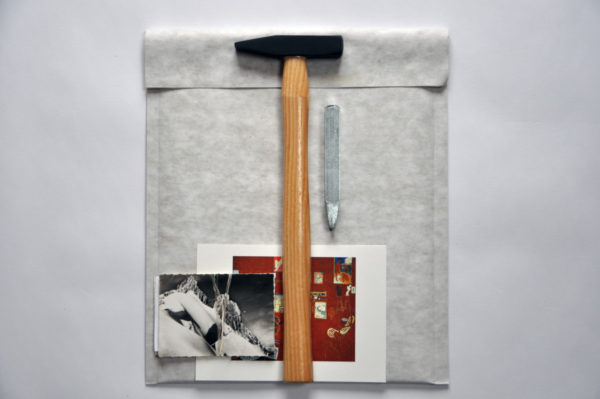
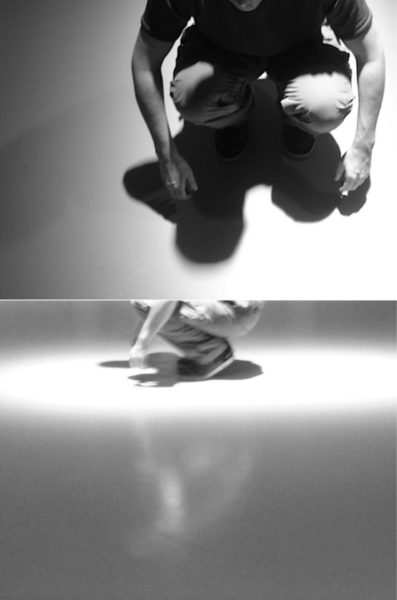
Marc Godts works and lives in Brussels. Experimental architect. Works in dimension zero. Co-initiator of the free association of designers fucklecorbusier/FLC extended working on spaces of limit, mixed reality and future conflicts. Teacher and researcher at KU Leuven, Faculty of Architecture, Sint-Lucas Brussels. Initiator of the explorative Masters trajectory in Architecture at the same and co-initiator of its upgrade: REAL trajectories. Doctoral study is action driven and concerns the relationship between creation and destruction: KILLSPACE. About an alternative awareness about architecture beyond just the built.
Om wereld en. Marc Godts, architect, 16 oktober 2015.
Met dank en als antwoord op de oefening die mij door Annelies De Smet gevraagd werd: stil te staan, alsof ik Matisse was, en ook niet langer dan 333 uur, bij wat voor mij, in mijn praktijk, omwereld is en doet, en daarenig spoor van te geven op plaats van betekenis, al of niet met hulp van objecten die ik bij die oefening van haar meekreeg. Van deze objecten bedien ik mij in deze oefening bewust niet, maar misschien onbewust wel, doordat ik zeer het mat én glanzend zwart smaak van het pakpapier, alsook het scherp van de beitel, de lichtheid van de hamer, het rotsvast dun en wit van het nylondraad. Ik ken al deze immers zelf ook van lang voor ik de selectie objecten kreeg, lijkt me, van in, vanuit en door mijn werk. En misschien kan dat teruggevonden worden in wat ik hierbij weergeef:
Virtuele interventies van, uit, in, met, door, tegen, voor en op het lichaam dat als plaats (het lichaam) steeds meer aan bijzondere betekenis wint in de activiteit waarmee ik mij verleen aan de architectuur en waarmee ik poog te werken naar en vanaf de grond, en dat met tweemaal niets en dat ten aanzien van wat ik de horizon van creatie-destructie noem. Waarbij ook de vraag naar dat lichaam, en haar geassocieerde lichamen (waarmee ze omwerelden maakt) steeds meer aan betekenis wint en dat niet enkel als gevolg van techniek. Evenals de vraag naar datgene wat vermag gevraagd en beantwoord te worden aan en door dat lichaam en haar associaties, in de architectuur of daarbuiten, evenals de vraag naar datgene wat niet – alsof lichaam en geest twee zouden zijn en alsof ik en al het andere twee zouden zijn. Vermeende grenzen en kern. Want ik weet niet wat ik doe. Dat daarom het werk voor mij ook niet is om toe te lichten, te duiden en te verklaren, maar om het doen of niet.
Marc Nagtzaam is a Dutch artist who lives and works in Belgium. His production consists mostly of black and white graphite drawings on different formats of paper. The subjects of these drawings are minimalistic patterns or grids, and representation of written words. The artist also produces spatial installations which replicate in three-dimensional form the abstract compositional logics of the drawings.
I have several collections: glass beads, necklaces, lots of pottery, African stools and headrests, many many many small objects and of course m-u-s-i-c.
In theory, I prefer the empty space but in practice I surround myself with all kind of things, piles of books and magazine, boxes of clippings and torn out pages. I try to store everything in bookcases and leave the walls empty. I don’t put a lot of of work on the walls and put my drawings in a chest of drawers as soon as they are finished. The computer is also an important tool to store images.
My working and living space is constantly mixed up.
Very important, I see the drawings as a constant dialogue with my audience. B y looking they can do with the drawings whatever they want. Also working with others artists is important, although I like it best when I can show my work in close relation to other artworks.
Graphic design / installation art / photography. The tools I use are photoshop, indesign, handsaw and cordless screwdriver, camera. The methods are the same: doubling, cropping, folding, rotating, cutting up, layering, looking, recording, editing, and putting things together in a new order and starting the process again.
I try to postpone everything till the point that all other distractions are gone and I can start with a new work. Collecting images seems important however there is seldom a direct link with the drawings. I make several models for each drawing and write down lists of the different types of drawings I’d like to make.
All my works are somehow connected. Falling into an amnestic state would mean I’ll become disconnected and not being able to find a meaningful way to continue. The relationship between the works and thus the different approaches are what interest me most.
I need a deadline, an exhibition, a context to start working. Then I start choosing and developing sketches which maybe are suitable. There is a stack of pieces of paper; sketches, words, torn out magazine pages, photo’s, I always return to.
No despair nor enlightenment, but I like what I’m doing.
A lot happens in the margins, I have to drag things from there into the centre. Maybe that’s my model, also to reconsider what I have already made.
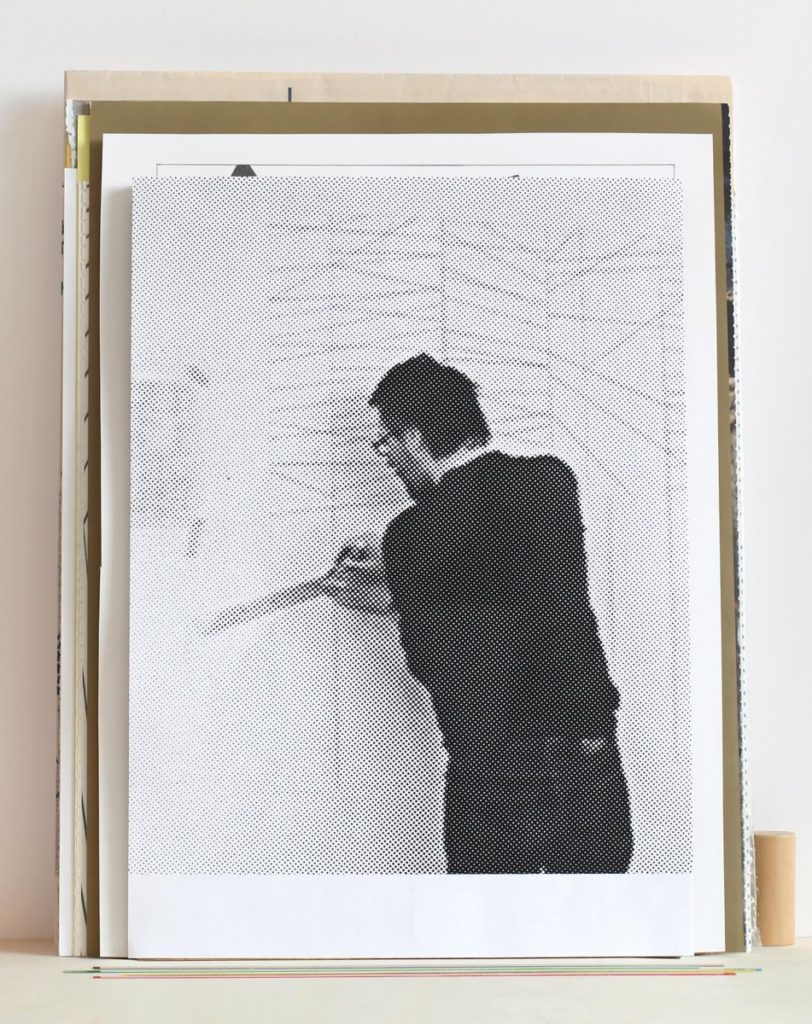
Portrait Marc Nagtzaam

Studioview
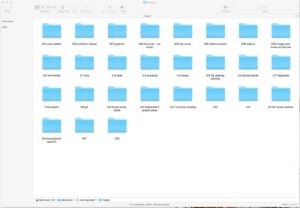
Screenshot
Rie Nakajima is a Japanese artist working with installations and performances that produce sound. Her works are most often composed in direct response to unique architectural spaces using a combination of kinetic devices and found objects.
I have never had a proper working space, I work in my room at home. I have books, but not much. I also don’t listen to music much, unless I feel the necessity or the urgency to do so. I am surrounded by objects which could become materials for my work. Those are on shelves or in boxes. They reflect my thoughts but they don’t belong to my work. They create a landscape that sometimes tells me where I am from and where I am going. My inspirations come from the people I know. I do have materials for my work, but I think eventually I don’t need anything.
I cannot talk about my work without talking about my collaborators now. I cannot do everything on my own. Also, there is no absolute answer in what I do. I do like collaborating with people who make me understand my limits. My collaborators and audiences are not part of my world/work. We can only articulate the boundaries between us, by understanding the differences and similarities between us.
I learn through making. That is the attitude of my life. There are lots of interesting moments in making, though I am not afraid of forgetting them as well. I take it easy with my memories. I don’t like to be stressed by them. If I fall into an amnesiac state, I hope I can still take it easy with my memories and enjoy nice food.
I consider my work as a continuous process. Every work starts with the questions from the previous works. There is no sense of finish in my practice and I think that’s fine. Deadlines help me to produce works but I also think they are not always necessary. There are so many starts and ends in life anyway!
